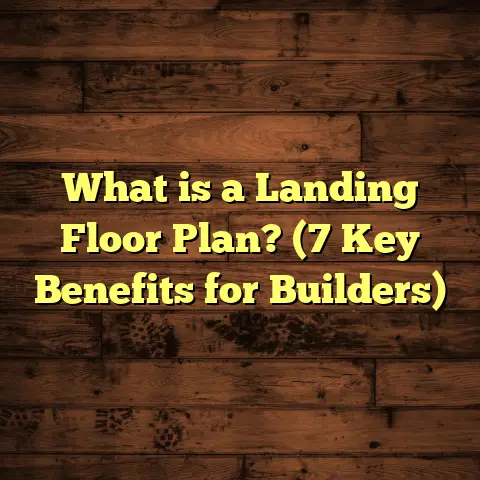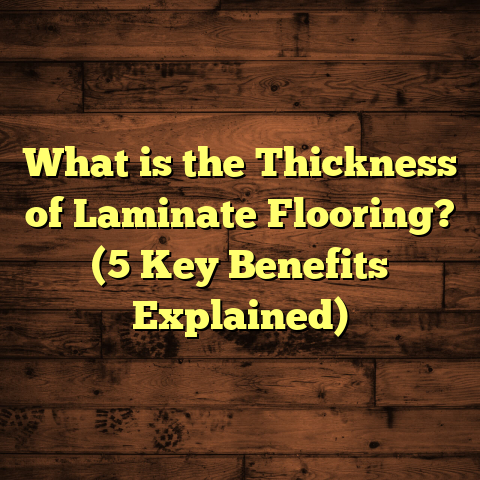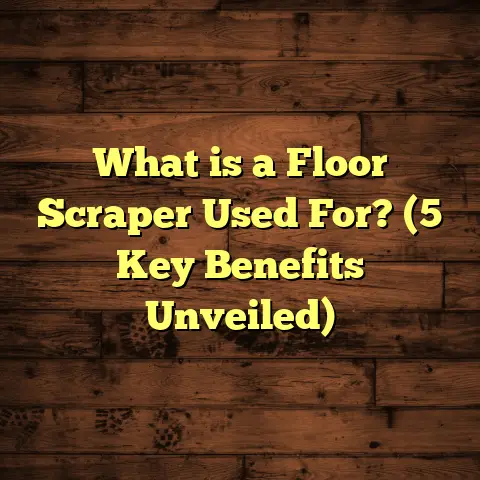What is Floating Vinyl Flooring? (5 Benefits You Must Know!)
Sometimes, when you’re trying to figure out what kind of flooring to put in your home or office, it feels like you’re stuck between a rock and a hard place. You want flooring that looks great, won’t break the bank, lasts for years, and doesn’t require a construction crew to install it. But it seems like every option has some catch, right? Hardwood floors look amazing but come with a hefty price tag and maintenance. Tiles are durable but cold and tough to install. Carpet can feel cozy but stains easily and wears out quickly.
That’s why I want to talk about floating vinyl flooring today. I’ve been working with flooring for years, and floating vinyl has become one of my go-to recommendations for clients who want a smart balance between style, durability, cost, and ease of installation. Maybe it’s something you haven’t thought much about yet. Or maybe you have questions like, “What exactly is floating vinyl flooring?” or “Is it right for my space?” I’m going to walk you through everything I know — the good, the challenges, what the data says, and real-life stories from my projects.
What is Floating Vinyl Flooring?
Let’s start with the basics.
Floating vinyl flooring is a type of synthetic floor covering made from layers of vinyl materials designed to look like real wood, stone, or tile. The key word here is floating — it refers to the way the flooring is installed. Instead of being nailed or glued directly to the subfloor (the surface beneath your finished floor), floating vinyl planks or tiles snap together and rest on top of an underlayment without any adhesive holding them down.
Think of it like building a puzzle, where each piece locks into the next tightly but you don’t have to glue or nail them in place. This means the floor “floats” above the base rather than being permanently fixed.
The Construction of Floating Vinyl Flooring
A typical floating vinyl plank has four main layers:
- Wear Layer: This is a transparent protective coating that keeps scratches, scuffs, stains, and wear at bay. Its thickness varies depending on quality; thicker wear layers mean better durability.
- Design Layer: This is where the magic happens visually. The design layer contains high-resolution printed images of wood grains, stone textures, or tile patterns that make the vinyl look realistic.
- Core Layer: Usually made from a vinyl composite or rigid PVC material, this layer provides stability and strength. It also helps resist impacts and dents.
- Backing/Underlayment: Some floating vinyl products include an attached foam backing that absorbs sound and adds comfort underfoot. In other cases, a separate underlayment is installed beneath the floating floor for cushioning and moisture protection.
How Does Floating Vinyl Flooring Install?
Installation is one of the aspects that makes floating vinyl so popular. The planks or tiles feature a click-lock system that allows them to snap together easily along the edges without glue or nails.
Here’s a simplified version of how installation usually goes:
- Prepare Subfloor: Make sure the subfloor is clean, dry, and reasonably level. Minor imperfections are okay because floating vinyl can tolerate some unevenness.
- Lay Underlayment (if separate): Some products require a foam underlayment to reduce noise and improve comfort.
- Start Snapping Planks Together: Begin in one corner and work your way across the room by locking planks together side-by-side and end-to-end.
- Cutting for Fit: Use a utility knife or saw to trim planks as needed along edges or around obstacles.
- Finish Edges: Install moldings or transition strips to cover expansion gaps around walls.
Since there’s no glue drying time or nails pounding required, installation can often be done in a day or two even in larger rooms.
Why Floating Vinyl Flooring Became My Favorite Option
I have worked with all sorts of flooring materials — hardwood, ceramic tile, laminate, carpet — and each has its pros and cons. But floating vinyl flooring fits a sweet spot for many homeowners and renters I’ve helped over the years.
One project stands out vividly: A young couple was renovating their kitchen and dining area but disliked how expensive hardwood floors were and worried about water damage from cooking spills. We went with floating vinyl planks that mimicked white oak wood — they loved how natural it looked without the risk of warping from moisture.
Because I had used FloorTally for estimating costs before starting installation, I confidently told them exactly what to expect on budget and timeline. The entire job wrapped up in two days with minimal mess — they were thrilled.
Since then, I’ve recommended floating vinyl floors for clients who want:
- Fast installation
- Waterproof surfaces
- A wide range of styles
- Low maintenance
- Good durability at an affordable price
The Upsides: What Makes Floating Vinyl Flooring Shine
Let me break down five key benefits I’ve seen firsthand that make floating vinyl flooring stand out.
1. Installation Is Fast and User-Friendly
One of the biggest headaches with flooring can be installation delays or costly labor fees. Floating vinyl floors are designed to be simple to install whether you’re a pro or a DIYer.
The click-lock system means you don’t need glue drying times or complicated tools. Over the years, I’ve seen installations done in kitchens, living rooms, basements — sometimes completed in just one day for smaller rooms.
I remember helping a client who wanted weekend installation while they were away on vacation; by Monday evening their floors looked brand new without any disruption.
This speed saves money on labor and minimizes downtime if you’re remodeling an occupied space.
2. Water Resistance Makes It Ideal for Moisture-Prone Areas
Traditional hardwood floors are notorious for being sensitive to water. Even small spills can cause warping or permanent damage if not cleaned immediately.
Floating vinyl flooring handles moisture much better because it’s made from waterproof materials — mostly PVC vinyl — which doesn’t absorb water like wood does.
This makes it perfect for kitchens, bathrooms, laundry rooms, mudrooms, or basements where humidity or spills are common.
In one project, I installed floating vinyl planks in a basement apartment that had previously suffered from minor flooding during heavy rains. Unlike previous floors that buckled or peeled when wet, the vinyl floor held up beautifully without any signs of damage months later.
3. Durability That Stands Up to Daily Wear
While floating vinyl isn’t as hard as ceramic tile or solid hardwood, high-quality products are surprisingly tough against everyday wear and tear.
The wear layer protects against scratches from pets’ claws, furniture movement, or heavy foot traffic.
In my experience working with families who have kids and pets, this durability matters a lot. They can spill juice or drop toys without worrying about ruining the floor.
According to industry data from Resilient Floor Covering Institute (RFCI), luxury vinyl plank flooring typically lasts 10-20 years if properly cared for — comparable or better than many laminate floors.
4. Comfortable Underfoot with Sound Absorption
Hard surfaces like tile or hardwood can feel cold and tough on your feet; plus they often echo footsteps loudly indoors.
Floating vinyl flooring often comes with an attached foam backing or you can add an underlayment beneath it that absorbs sound and cushions impact.
I once visited a client who had installed floating vinyl throughout their open-plan living space. They told me how much more comfortable it was standing in their kitchen all day compared to previous tile floors.
This comfort makes it great for kitchens where people spend long hours cooking or basements converted into playrooms or offices.
5. Style Variety to Suit Any Decor
When selecting flooring for clients, one thing I hear repeatedly is “I want something unique but affordable.” Floating vinyl really shines here because manufacturers offer hundreds of colors, patterns, textures mimicking natural materials like:
- Oak
- Maple
- Hickory
- Slate
- Travertine
- Marble
You can find everything from rustic farmhouse looks to sleek modern styles at different price points.
This versatility allows homeowners to match floors with their existing furniture and interior design goals without paying premium prices for exotic woods or natural stone tiles.
I once assisted a client who wanted a coastal vibe in their beach house but couldn’t justify installing pricey hardwood throughout. We picked a floating vinyl plank with weathered driftwood visuals that nailed the look perfectly.
What About Challenges? Some Things You Should Know
No flooring material is flawless — floating vinyl flooring has its own downsides I want to be upfront about based on my experience.
Feeling Less Solid Compared to Real Wood or Tile
Some people notice that floating vinyl doesn’t feel as sturdy or substantial underfoot as hardwood or stone tiles. This is especially true for lower-end products with thin cores.
I remember a client mentioning their initial hesitation because they expected a harder feel but found it “softer” or “hollow” when walking barefoot. To fix this, using quality underlayment helps improve the feel significantly.
Potential for Expansion Gaps if Not Installed Properly
Vinyl expands and contracts slightly with temperature changes more than hardwood. If installers don’t leave proper expansion gaps along walls or doors, planks can buckle or gaps may appear over time.
In some older homes with uneven subfloors, I’ve seen slight movement noises after installation due to insufficient underlayment thickness.
These issues are avoidable by following manufacturer guidelines carefully regarding acclimation time and gap allowances during installation.
Not Always Repairable Like Hardwood
If a plank gets damaged beyond repair—say deep gouges or burns—it usually needs replacement rather than refinishing like hardwood floors allow.
However, since floating vinyl planks are installed individually without adhesive underneath, replacement tends to be easier than glued-down options.
Environmental Considerations
Vinyl flooring involves synthetic PVC materials which raise environmental concerns about manufacturing emissions and disposal at end-of-life compared to natural wood floors.
For clients prioritizing eco-friendliness strictly, this can be a drawback even though newer products are improving recyclability.
What Does Research Say About Floating Vinyl Flooring?
To back up what I’ve observed personally with some numbers:
- According to Freedonia Group’s market report on resilient flooring (which includes vinyl), sales of luxury vinyl planks grew at an annual rate of about 7% over recent years in the US alone.
- Nearly 40% of residential resilient flooring market share now belongs to luxury vinyl products including floating types.
- Satisfaction rates from homeowner surveys hover around 85% when asked about durability and ease of maintenance.
- HomeAdvisor data shows average installed costs between $2-$7 per square foot for floating vinyl compared to $8-$15 for hardwood floors.
- Studies also highlight how waterproof features reduce repair costs linked to moisture damage by up to 50% over 10 years when compared with hardwood in kitchens/bathrooms.
These statistics reflect what I see daily — homeowners want affordable yet durable options that fit busy lifestyles without sacrificing style.
How FloorTally Makes Budgeting Easier on My Projects
Budgeting flooring projects can be tricky—material costs vary by region; labor fees fluctuate; waste percentage changes depending on room shape and cuts needed.
That’s why I rely on FloorTally as part of my workflow. It lets me input room dimensions along with local pricing data for materials and labor automatically pulled from real-time sources.
By selecting specific brands and thicknesses of floating vinyl options within FloorTally’s interface, I get accurate estimates including waste factors built-in so I don’t end up ordering too much—or worse—too little material mid-project.
For example, during a recent multi-room installation for a client upgrading their rental units with floating vinyl plank floors:
- FloorTally helped me quickly compare estimated costs across three different product lines based on durability vs price.
- It also suggested ideal quantities accounting for cuts around doorways minimizing leftover scraps.
- This saved me hours usually spent calling suppliers or manually calculating numbers in spreadsheets.
- As a result, we stayed well within budget while choosing high-quality materials that pleased tenants.
If you’re tackling your own project—or managing multiple jobs—tools like this help take some guesswork out of budgeting so you can focus more on design choices instead of crunching numbers all day long.
A Closer Look at Real-Life Projects With Floating Vinyl Floors
Case Study 1: Basement Renovation Success
A family contacted me wanting to finish their damp basement into a kid-friendly playroom plus office space downstairs. They wanted floors that wouldn’t get ruined if water seeped in during heavy rains but still felt warm and inviting.
We chose floating vinyl planks with an attached cushioned backing designed specifically for basements prone to moisture fluctuations.
Installation took two days; no demolition was needed since we laid the floor directly over existing concrete slab after cleaning/leveling briefly.
Six months later they reported zero water damage signs despite one rainy season causing minor flooding outside windows — plus their kids loved playing on warm cushioned floors instead of cold bare concrete!
Case Study 2: Rental Property Makeover
A landlord managing four apartments needed quick upgrades between tenants but wanted durable surfaces that required little upkeep.
Carpets had been stained repeatedly; hardwood was cost-prohibitive given rental income margins.
We installed floating vinyl plank flooring throughout each unit using mid-range products balancing cost vs durability features. FloorTally helped me estimate total material/labor costs accurately across all units before purchasing materials — avoiding costly overstocking mistakes last time we did similar projects manually.
The landlord reported higher tenant satisfaction scores after renovation plus lower maintenance calls related to flooring issues during tenancy renewals over next year.
Case Study 3: Kitchen Renovation for Busy Homeowner
A single mom wanted new kitchen floors that could handle daily spills from kids without needing constant refinishing like her old hardwood required after years of wear and tear.
We laid down waterproof floating vinyl planks mimicking warm walnut wood tones she loved while fitting her budget constraints tightly thanks to early cost estimates via FloorTally’s options comparison feature.
She later told me she appreciated not having to worry about stains anymore plus how easy cleanup became after cooking messes — all while maintaining stylish appearance matching her kitchen cabinets perfectly.
Maintenance Tips That Keep Floating Vinyl Looking New
One thing clients often ask me: “How do I keep this floor looking good?”
Floating vinyl is pretty low-maintenance compared to other surfaces but here are some tips I always share:
- Sweep regularly with soft broom or vacuum without beater bar to prevent grit scratching surface.
- Mop occasionally using manufacturer-recommended cleaner diluted in water (avoid harsh chemicals).
- Wipe spills immediately especially oils or colored liquids.
- Use furniture pads under heavy chairs/tables to avoid dents.
- Avoid dragging heavy objects across floor; lift instead.
- Keep pet nails trimmed if you have dogs or cats.
Following these simple steps can extend your floor’s lifespan well beyond warranty periods provided by most manufacturers (typically 10–20 years).
FAQs About Floating Vinyl Flooring From My Experience
Q: Can floating vinyl flooring go in bathrooms?
A: Yes! It’s one of the best choices for bathrooms because it resists water damage unlike hardwood floors which warp easily when wet.
Q: Can I install floating vinyl over existing tile?
A: Absolutely. One major advantage is you often don’t need to remove old tile if it’s level — just clean thoroughly first then install over it using proper underlayment if required by manufacturer specs.
Q: Is floating vinyl flooring noisy?
A: It depends on underlayment quality but generally no louder than hardwood floors; many options include sound absorption layers minimizing footstep noise effectively.
Q: How long does floating vinyl flooring last?
A: With normal residential use and care? Around 10–20 years depending on product quality and traffic levels which compares well against laminate alternatives lasting about 7–15 years typically.
Q: Is it safe for pets?
A: Yes! The wear layers protect against scratches from claws; plus easy cleanup helps maintain hygiene when accidents happen occasionally indoors.
Floating vinyl flooring brings together affordability, style flexibility, durability, water resistance, easy installation—and did I mention comfort? From personal projects helping families upgrade kitchens fast without disruption to landlords improving rental units affordably yet attractively, it’s become my reliable go-to solution when clients want good value without sacrificing aesthetics.
If you’re thinking about new floors but feeling overwhelmed by choices, floating vinyl deserves serious thought. Have questions about whether it fits your specific situation? Let’s chat—I’m happy to share insights tailored from my hands-on experience plus data-backed advice so you get exactly what works best for your space and budget!





